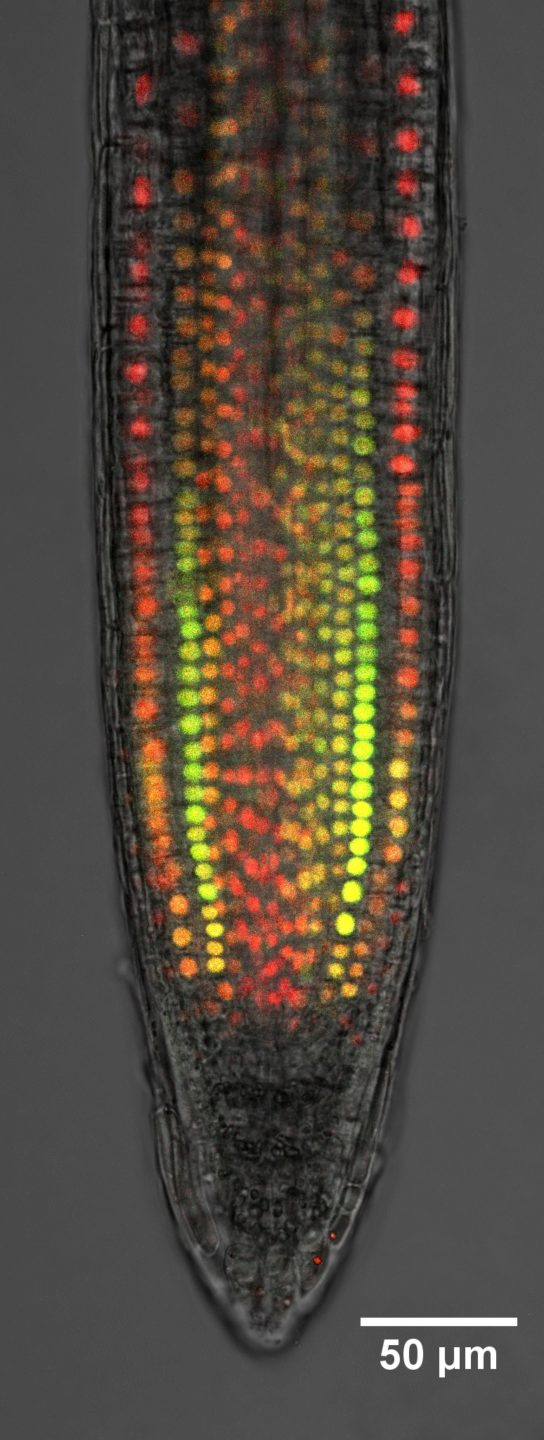June 25, 2018
New mechanism for the plant hormone auxin discovered
Study in Nature Plants reveals a new mechanism in roots’ response to gravity

© Matouš Glanc
Auxin is a hormone that is essential for the development of plants as it controls a wide range of processes from shaping the embryo in the seed to branching of the growing plant. Previously, it was believed that auxin’s main signaling mechanism operated in the cell nucleus and acted only by regulating gene transcription. Now, scientists led by Jiří Friml at the Institute of Science and Technology Austria (IST Austria) have demonstrated that another mechanism exists, and that cells in the roots must be able to respond to auxin immediately. This mechanism enables rapid adaption of root growth direction.
When the seed of a plant germinates, its root needs to quickly establish the direction of gravity and bend to grow deeper inside the soil, where it can anchor itself, and find water and nutrients. In order to bend, cell growth is allowed to continue on one side of the root while being inhibited on the other. This inhibition was known to be triggered by the hormone auxin and to happen very quickly, but the exact reaction times were difficult to measure. Using an innovative setup, the researchers could now measure the time roots need to react to changes in the auxin concentration precisely. They concluded that the extremely rapid adaption of growth rate was far too fast to be explained by the gene transcription mechanism, and therefore must involve a correspondingly rapid perception mechanism.
New branch in an old pathway
But the new mechanism is not entirely unknown. Components of the well-studied pathway, the TIR1 receptor, are needed for the newly discovered mechanism. “With our experimental setup, we proved that the signaling is indeed non-transcriptional, but we have seen that components of the original transcriptional pathway are needed,” explains Jiří Friml, Professor at IST Austria and leader of the research group. “This means that we are not looking at an entirely new pathway but at a new branch of the canonical pathway,” he adds.
With a flipped-over microscope and liquid-filled microchannels
With a microscope that was flipped on its side—a method that was developed previously by the same research group and that led to the production of a breathtaking video of growing roots that won last year’s “Nikon Small World in Motion Competition”—the team was able to observe the roots grow in their natural orientation. But measuring the reaction time required further development of the technique: they needed to be able to quickly change the solution the roots grow in.
“Normally, people would apply the auxin and then mount the sample to the microscope, but with this method, they would lose precious seconds or even minutes—and exactly those first few minutes are the ones that were essential for this study,” explains Matyáš Fendrych, leading author of the study, former postdoc in Jiří Friml’s group and now assistant professor at the Charles University in Prague. The solution found by the team was to let the roots grow in microscopic channels filled with the desired liquid. “This allowed us to change the auxin concentration and immediately measure the root’s reaction,” he adds.
Publication
Matyáš Fendrych et al. 2018. Rapid and reversible root growth inhibition by TIR1 auxin signaling. Nature Plant. DOI: 10.1038/s41477-018-0190-1



